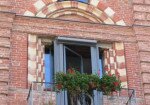Donatien Alphonse François, Marquis de Sade travel in Piedmont (“prison and writing”) (taken from: lafrusta.homestead.com, written by Sergio Skep)
“Un jeune homme d’une taille moyenne, assez rempli, cheveaux blonds, portant épée, vêtu d’un frac gris, culotte en soie couleur souci, ayant une canne à pomme d'Or”
The knowledge of the reported, anodyne, description (that “ictu oculi” reveals its origin in a police report) might have allowed – apart from the clothes – to the curious people from Asti to identify the character who, the 26 July 1775, with the escort of a servant, was wandering the streets of the City, by visiting a bit’ absently the monuments and – it is a well-founded assumption – much more carefully not the few brothels. Learn the name of the stranger, they would not, however, taken from this knowledge so much interest of: thanks to this, in fact, they would basically only been aware of the fact that the blonde passenger turned out to be a headline across the Alps, belonging to the “category”, then rather crowded, of the Marquis and with some judicial trouble pending. Much greater attention it is instead the attemtion that this name arouses today, since he, far from referring to an eighteenth century noble, is well known to Justice, as he belongs to him who has gone down in history as the “Divine Marquis“.
That of July 1775 turns out to be the only documented occasion where we can with certainty say that Donatien-Alphonse-Francois Marquis de Sade would stay in Asti, but it can not be excluded – indeed it seems likely – that other times he had the good fortune to cross it. Dates in fact in 1772 his first trip to Italy, for sure a leisure travel, as done together the beloved sister in law, Anne-Prospére de Lonnay, chanoinesse not precisely cloistered, that he was always introducing as his legitimate wife, taking with her – how the Count de la Tour pointed out – toutes les privautés dues à ce titre.
The decision to leave for the Italic shores was rather hasty, as the Marquis, passing through Marseille, along with his manservant and accomplice Latour, was involved, the 27 June, in the so-called affaire des quatre filles marseillaises and on this orgy – because this it is – the courts soon opened an investigation. (The description of de Sade that begins this post is in fact taken from the minutes of the "Procédure de l'affaire de Marseille", published by M.Heine). He estimate that it was therefore highly appropriate (“nihil sub sole novi”) to put between himself and the investigators a border and, while at the end of the judicial process a sentence in effigy was executed in a square in Aix, He, with the casual canoness, gaily visited the Bel Paese, touching, among other cities, certainly Genoa and Venice.
The first Italian sojourn ended, however, traumatically, with the arrest, the 8th of December, 1772, in Chambery, by order of the King of Sardinia. The next three years de Sade was involved in many daring stories, including an escape from the fortress of Miolans (10 May 1773) and an uninterrupted series of erotic scandals. After the last of these, known as the affaire des petites filles, the 26 June 1775 escaped again for Italy, where he remained for about a year. This long stay was literary interesting, since he left many information in a manuscript, published for the first time by G. Lely and G. Daumas, under the title Voyage d'Italie, or dissertations critiques, historiques politiques et philosophiques sur le villes de Florence, Rome et Naples 1775-1776. From the prolonged Italian experience he took advantage also for the preparation of the novel L'Histoire de Juliette ou les prospérités du vice, work that, together with Justine ou les malheurs de la vertu, caused his final arrest, the 6 March 1801, as the author of scandalous writings. From reading the travel diary we learn that his first major Italian stage was Turin, that touched the 25 July, early, and where he stayed one day. Perhaps because of the brevity of his stay, the observations on the city are quite obvious and generic. The capital of Piedmont seemed to him a ville (…) d’une belle construction and pointed out in particular that les églises y sont superbes, les rues belles, presque toutes alignées, et les maison bàties au méme niveau. He judged Palazzo Reale assez vaste et commode mais de peu d’apparence. He liked also the royal gardens, while it was adversely affected by Palazzo Carignano, as, though it seems large, il est en brique et n’a rien ni de magnifique ni d’agréable. As for the customs of the city seemed marked à la plus grande sévérité. (The Turin of the ' 700 is not very Jolly is not consideration attributable to the libertine spirit of our: about 50 years before even the austere Montesquieu had not skimped on acidic remarks on the standard of living of Servet). De Sade does not fail to provide tourist information about Charming d'Angleterre (site – as we learn from the leadership of Derossi in 1781 – the Church of Santa Teresa, Canton of San Eusebio), defined best hotel in Turin, as, Although tumultueuse comme toutes les grandes auberges (…) on y est et bien logè et bien servi. Even more stingy on City News is the description of your stay in Turin by Juliette (The protagonist of the novel mentioned above). The girl, arrived in the capital of Piedmont, takes about well-defined usefully employ the Italian stay for real economic advantage to draw all its beauty: in doing this, however, do not neglect any opportunity to stir the most daring physical stunts than, no less daring, of intellect. (As for the first, vale, for “incidens”, observe how, considered the physical attribute that mostly values – indulging, in his opinion, to a precise “taste” italico – She is certainly notable with Moroso to certain “heroines” moraviane, by some predictions’ details). You can, here, neglect to invoke its hyperbolic in detail – but tasty – Turin's adventures in porn-philosophical background-politician-truffaldino (Juliette basically represents a curious synthesis of moods of the century), whose mechanics, so absurd and ironic, I help with the judgement, whimsical at first, by Arbasino, which considers the divine Marquis comic rather than erotic writer: However, it seems to me interesting to recall how our heroine does not fail to express a rather harsh assessment about the city and its inhabitants. Such assessment would say both and Assumable that most authentic opinion of de Sade on Turin, because it is intuitive as, speaking through the mouth of a character in the novel, have got to speak with greater freedom his most intimate thoughts, not writing in first person. Il n'y a point, dans toute l'italie, de ville plus ennuyeuse régulière et plus que Turin: le courtisan y est fastidieux, the Diego citadin fort triste, le peuple dévot et superstitieux.
The voyage of the Marquis, accompanied by the ambiguous servant Carteron, said La Jeunesse, resumed late in the afternoon of the same 25 July, with destination Asti. The two, though, fiddly local topography, passed without knowing our city and had to stay in a place, three leagues from the same, on which, given the vaghissime instructions, doesn't seem useful attempt to advance some hypotheses of identification: Cette poste est située dans une campagne des plus agréables et serait prise pour un fort joli chateau partout. L ' intérieur ne repond pourtant pas à l ' extérieur et la chère surtout hateful y est. The 26, At last, de Sade came in Asti: the city certainly doesn't enthusiasmed: Cette ville, prodigieusement déchue de son ancienne splendeur, presque rien n'est plus Aujourd'hui. (The phrase is found identical in Juliette, as the only commentary on the passage in the city). Note the ancient walls, that indicates the State of abandonment. He stressed the fact that, at the time of your stay, It was headquartered in loco even a military garrison. Is happily struck by certain religious buildings, but proves to be anything but precise diarist at the time to describe them. So is expressed: On voit deux belles églises dans cette ville, entre autres celle des Religieuses, peinte et ornée avec tant de goùt qu'on la plutòt prendrait pour une décoration d ' opéra que pour un temple de la divinité. On the sidelines of the term celle des Religieuses exist, in the original manuscript, the cryptic remark son nom. Given the fact that in other places of the narrative we come across in this record, I would say that it should be regarded as a sort of reminder of the author, with a view to a final redaction of the diary: not Recalling, at the time of first draft, the exact designation of certain buildings, took note of the need to deepen the question, rinvenirla waves. However, not having ever more dedicated to planned overhaul, the data supplied in primitive stationed, vague, drafting. In the case under examination, I believe that from the specification we can infer des Religieuses that the Church had a convent of nuns. This feature fits in more religious buildings existing at the time: as it turns out, however, by accurate feedback left by Abbot Incisa, in none of them can be found significantly the peculiarities shown by the Marquis. (1) It only remains, therefore, take note of what he writes, without excessive load him kind and inaccuracies (and, in some cases, incorrectness) the news passed: in fact, should not be disregarded as our, by its very nature, It was definitely more traveler attracted by new “human contact” that since the discovery of the monumental beauties, and in the background is much more at ease when builds, with unbridled imagination, the libertine Juliette's journey when provides, by competing with reality, account of its. In the evening of 26 de Sade found already in Alexandria, dite de la paille, where is the accommodation Hotel d'Angleterre, the best in town, remembered by many travellers of seven and 19th century (Les appartements sont beaux et bons, la délicate de chère pour le pays, la maison de belle apparence, mais les prix excessifs).
Even the living room Alexandria is fleeting (shares in the afternoon of 27), However it provides wide enough account. With expert eye of former soldier of the seven years ' war note the inadequacy of defensive walls, but appreciates in value the right firmness of the Citadel (la citadelle, séparée de la ville par le Tanaro que l'on passe sur un beau de pont, est très forte). From man of the world underlines its elegance of the city (Elle me parut habitée et je comptai bien plus de quarante équipages à la promenade) and no shortage of irony on galanti – certainly not just Parisians – the officiality of Savoy. Remember how, After the walk in a carriage, We both use de venir se faire voir sur la place d'armes. Les carrosses s'y rangent, les officiers aux portières montent, and there all Piedmontese gallantry unfolds. Quanto have monumenti cittadini fornisce notizie della cattedrale, del municipio e di a palazzo terzo. In Reed tale circostanza it Nostro non manca di essere confuso. Senza soluzione di continuità rispetto al passo da ultimo citato, COSI si gesuiti: “This place is long but poorly built. Were built, When I spent, a pretty nice building but that alone does not enhance it. The Cathedral, Gothic and exterior unadorned building, takes alone almost one of the long sides, and mask quite a beautiful town hall, located on a species of extension, the return of this place. In the construction of this city hotel, comment on est de voir le premier ordre de colonnes infiniment inférieur au second. Ce défaut choque infiniment, surtout dans un bàtiment modern here, sans cela, aurait quelque beauté “. The Cathedral is appropriate: He refers to the old cathedral of Alexandria, the austere facade painted with red and white horizontal stripes, on the site of the current site freedom square, whose foundations were contemporary to date almost the founding of the city. The duomo, with the famous square bell tower (on which was placed the three clock dials, currently embedded in the facade of the Town Hall), was shot down thirty years after a visit to Alexandria of de Sade, in 1803, by order of Napoleon's Government. With regard to the building under construction it, Despite its location at the indicated place d'armes, It may be only the current Town Hall (on this ID agree even the aforementioned editors of the printed edition of the manuscript), whose partial reconstruction was in fact entrusted, in 1774, the architect Caselli, and for which, in 1775, they stirred jobs. (The factory will – as it known – Yet changes in later centuries). It remains finally to locate the building, “masked” from the Cathedral, the divine Marquis calls a charming de Ville. In relation to what you just said, given the stated position of the Palace, fornitane description and its recognized modernity, I don't think they can be in no doubt that it should be found in the alfieriano Palazzo Ghidini. To de Sade's comfort you can still remember that aesthetic reserves advanced by him on the facade of the building found solace in the thought of Mallé (The arts in Piemonte, Vol. (II), p. 95), which imputes to the Bishops his excessive rigidity and the fact that he had found for it “even some guariniano intellectualism and a more staid label stamp”. As we have already said the day 27 our leaves Alexandria: for him, as for Juliette, the Italian adventure is just at the beginning.
(1)- This may be part of the Church of the convent of S. Anna.Il Baroque bell tower of the Church is the first architectural work by Benedetto Alfieri. (See. S. Taricco, Benedetto Alfieri, in ” Il Platano “, at. The, n. 1, January-February 1976, pag. 5 and seg).
Bibliographic notice
For a global knowledge production and of human affairs of the Marquis de Sade to stringent Oeuvres Complètes referral du Marquis de Sade, Edition définitive, Paris, MDCCCCLXVI. In l'histoire de Juliette, ou la prosperité du vice is placed in volume VIII, While Voyage d'Italie, ou Dissertations critiques, historiques, politiques et philosophiques sur les villes de Florence, Rome et Naples 1715-1776 in XVI. The Edition, of limited circulation, It is rarely found in Italian libraries.
The complete documentation for the ” Marseille procedure ” is contained in M. Heine, Le Marquis de Sade, Texte établi et préfacé for G. Lely, Paris MDCCCCLX.






 Decameron. First Day. 5th Novel
Decameron. First Day. 5th Novel 




 Do you want to highlight your event or business?
Do you want to highlight your event or business? Alessandra Scotti Web Design Art Director, graphicsdesign, webdesigner
Alessandra Scotti Web Design Art Director, graphicsdesign, webdesigner B&B La Rana e La Salamandra House for rent and Bed & Breakfast in Loazzolo
B&B La Rana e La Salamandra House for rent and Bed & Breakfast in Loazzolo Educational Farm ArteMiele Genuine products and educational workshops to discover bees and silkworms
Educational Farm ArteMiele Genuine products and educational workshops to discover bees and silkworms